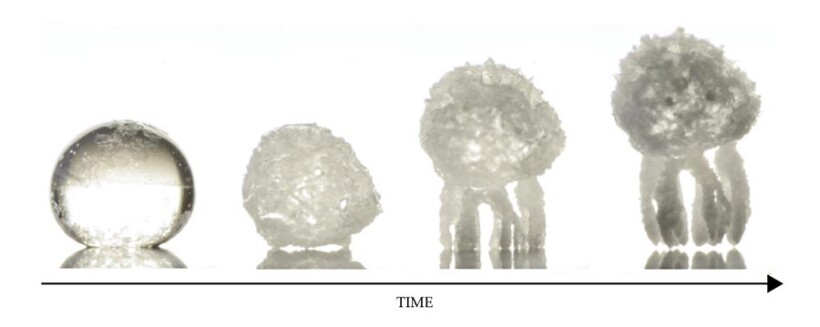Salt crystals remove themselves from hydrophobic surfaces
To cool hot equipment, water is sprayed on or run across its surfaces. Evaporation is a vital part of that heat exchange, but it leaves behind minerals that form a crust. The accumulation of those precipitates reduces the efficiency of heat exchange and can corrode and clog pipes. Indeed, this past year in the US alone, some $50 billion was lost by treatment and power-generation facilities because of heat-exchange surfaces that had been fouled by salts and other minerals.
Reverse osmosis and other water pretreatment efforts prevent the fouling but are expensive. The interaction between crystal precipitates and metal surfaces further complicates the treatment. With the increasing importance of water conservation, Samantha McBride

S. A. McBride, H.-L. Girard, K. K. Varanasi, Sci. Adv. 7, eabe6960 (2021)
When the researchers began studying how salts crystallize, they found that the precipitating minerals initially form a shell around water droplets. As the mineral-saturated water continues evaporating and condensing, they noticed that the shell often rises from the substrate by growing crystalline legs. The photo shows the effect; here, it starts with a 5 µL droplet on a 90 °C surface. The legs, the researchers discovered, are hollow, and saltwater flows down them and precipitates at the base. The shape of a salt blob atop those legs makes it resemble an animal, which the MIT team termed a “crystal critter.”
The length of their crystalline legs (typically microns) and the time required for them to grow (typically minutes) depend on the temperature of a hot, hydrophobic substrate. The researchers created their substrate by etching nanoscale ridges that were fractions of a micron wide, and they monitored the legs’ growth with temperature: The hotter the substrate, the faster the growth.
Eventually the legs become too long to support the weight of the shell on a substrate and it breaks off. Removed from the surface, the crystal critter is then swept away. The natural and continual ejection of such salty blobs from substrates could dramatically reduce the costs associated with heat exchange and could preserve fresh water for other vital purposes. (S. A. McBride, H.-L. Girard, K. K. Varanasi, Sci. Adv. 7, eabe6960, 2021